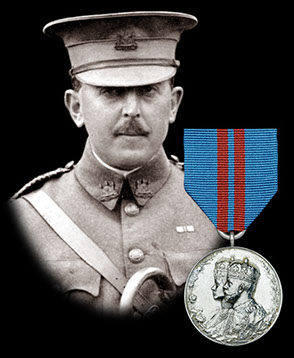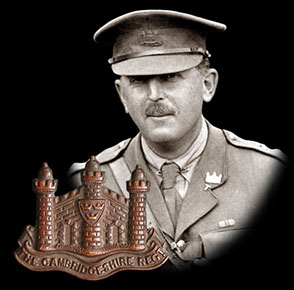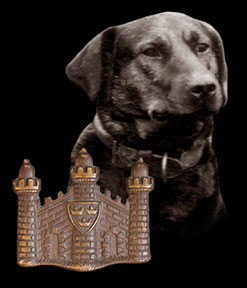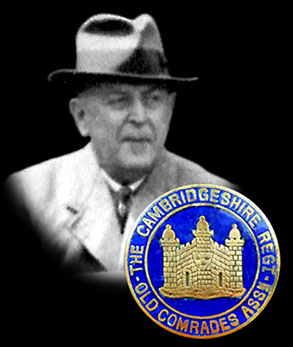
Who Were
The Cambs
The Cambs
at War
1/1st Btn 1914-1919
1914 - 1/1st Overview
1915 - 1/1st Overview
1915 - St Eloi
1915 - Fosse Wood
1916 - 1/1st Overview
1916 - The Schwaben
1916 - St Pierre Divion
1917 - 1/1st Overview
1917 - St Julien
Insignia, Medals & Books
Remembering The Cambs
Biographies
About Us &
This Site
Ely's Staunch Territorial Officer
Of all of the 1/1st Battalion, Cambridgeshire Regiment’s wartime commanding officers, the one that most embodies the stereotypical figure of a pre-war Territorial Force officer during the first half of the War is Lt Col Archer. In his late thirties, he was over a decade older than many of his new fellow officers and he had already served for many years in the Volunteers and later the TF. An important figure in his local town, he had grown up, lived and worked alongside many of the men he commanded and, as such, cared about them deeply. With a keen interest in military tactics and modern warfare he had studied and even written about the subject before the War. However, in 1916, despite his numerous qualities, Lt Col Archer fell victim to the ugly pre-war attitude still shown towards the TF by some senior figures. In many ways though, this unfortunate and unjustified event spared both Archer and his beloved battalion from something far worse months later on the Somme, where, despite his best efforts, it is arguable that he would have been out of his depth and overcautious in the face of the losses.
Lieutenant Colonel Goodwyn Luddington Archer TD
Arguably one of the most influential individual characters in Ely in the first half of the 20th Century, Goodwyn was born in 1878, the son of an important local solicitor named Harold Archer and his wife Sophia nee Luddington. The young Goodwyn spent his early years at the family home on the Market Square in Ely before leaving for boarding school at Framlingham College and then St Peter’s College, Radley. His mother’s family, the Luddingtons, had a long association with the armed forces with members serving in both the Regular Army and the Militia. In June 1898, shortly after returning to Ely at the end of his education, Goodwyn carried on this family tradition after he accepted a commission as a 2nd Lieutenant in H (Ely) Company, 3rd Volunteer Battalion, Suffolk Regiment.
Under the watchful eye of Capt Louis Tebbutt, Goodwyn fitted in well with the Company and was promoted to Lieutenant in March 1900. Later in the same year he qualified as a solicitor and joined his father’s law firm in Ely. After just over five years service in the Volunteers and at the young age of 25, he was promoted to Captain and appointed as the Company Commander of the Ely Company. He was soon joined in H Coy by another well known figure in Ely, Philip Cutlack, who was commissioned in 1904. Archer totally immersed himself in the two key parts of his life – his work at the firm and the Volunteers, he proved to be highly successful in both.
When the Volunteer Battalions disbanded in 1908 Goodwyn immediately joined the newly formed Territorial Force and remained with the Ely Company. In December 1911 he was promoted to Major and took on the duties as Officer Commanding of the Fenland half of the Battalion. After war erupted in August 1914 Goodwyn quickly became Second in Command of the newly created 1st Imperial Service Battalion and preparations were made for service overseas.
During this chaotic time of intensive training and the frustrating interruptions caused by invasion scares, Goodwyn, at the age of 36, married Phyllis Etson at St Cuthbert’s Church, Kensington on January 9th 1915. The newly married couple did not have long together before Archer left for France with the Cambridgeshires on February 14th 1915. Archer took with him his ever-present faithful companion and battalion mascot, his dog Jack.
Just over two months after arriving on the Western Front the Cambridgeshires’ Commanding Officer, Lt-Col Copeman, was invalided back to the UK suffering from sciatica, Major Archer was appointed as the new CO and promoted to Temporary Lt-Col. Archer proved himself to be a capable battalion commander and handled his men well during the trying days in the Ypres Salient and the supposed quite sector around Armentieres.
In February 1916, after the Cambridgeshires successful stint as the 3rd Army School’s Training Battalion, the Battalion was informed they would be joining a new brigade. This new brigade, the 118th Brigade, was to be made up of four other battle-tested Territorial Force battalions including the Cambs. The 39th Division that this brigade was to be a part of however was not a Territorial Force division, instead, it was part of the wartime raised “Kitchener’s Army” and, apart from the 118th Brigade, was made entirely of inexperienced units straight from the UK. This mixture sadly brought up some of the pre-war politics and prejudices felt by some senior officers towards the Territorials and a rather awkward period ensued.
On April 2nd, Lt-Col Archer was caught in the blast of a nearby shell as he exited his dugout, he suffered minor shrapnel wounds to his face and was left suffering from the effects of the concussion. A week later he returned to the UK for a fortnight’s leave, unfortunately for Archer this leave coincided with the arrival of a new Brigadier who was to command the 118th Brigade. Possibly due to a negative attitude towards TF officers or possibly looking to make an example of somebody, this new Brigadier found several minor faults with the Cambs during an inspection and immediately started the process of getting Archer removed.
Goodwyn was summoned back halfway through his leave, despite the support of many of his previous superiors he was informed he was to be replaced and would be sent back to the UK. The damning report compiled by the Brigadier, with the support of the Division's commanding officer, requested that his replacement should be “a young Regular Army officer”. For Archer, despite the numerous letters of support and recognition of his good work over the year he was CO, there was no reprieve and he lost his command and was returned to the UK.
This low point in Archer’s life was exacerbated by the rather public and embarrassing disintegration of his brief marriage after it came to light that she had been having an ongoing affair, the couple were divorced in late 1916. After a year on the TF Reserve Officers list Goodwyn was given command of one of the Cambridgeshires' reserve units, the 4/1st Battalion. His valuable war service was also recognised by an official mention by the Secretary of State for War and his acting rank of Lt-Col was made official.
Demobilised at the end of the War Goodwyn returned to Ely and the family law firm. In 1922 he was elected to serve on the Ely Urban District Council, a role that he was to hold for 36 years. A truly formidable character in the local area he held a string of other positions and duties including; Deputy Lieutenant, Chief Fire Officer, County Treasurer for the St John Ambulance Brigade and President of the Cambs Regt Old Comrades Association. Alongside these positions and many others he was also an important figure in the local Freemasons, initially joining St Audrey Lodge at Ely in December 1917.
During the Second World War, while in his sixties, Goodwyn served as the Civil Defence Controller for the Ely area and played an active part in the local Home Guard. Archer never remarried after his disastrous marriage to Phyllis, he was however close to his three sisters and their families. His nephew John Goodwyn Allden Beckett followed in his footsteps by joining both the family law firm, Archer and Archer, and the Cambridgeshire Regiment where he reached the rank of Colonel.
For many years Goodwyn lived on Silver Street in Ely, in the now demolished, old Militia Quarter Master’s house, named “The Dugout” by Archer. With his demanding (at times intimidating) character and after his lifetime of involvement in a wide range of organisations he was a well-known but slightly reclusive figure. He was remembered by many of those who served with him in the Cambs as being a hardworking officer whose first thoughts had always been for his officers and men. He died at Ely at the age of 84 on November 26th 1962.

Capt Archer, while commanding H (Ely) Coy.

Goodwyn, shortly after receiving his 1911 Coronation Medal.

Lt Col Archer, while CO of the 4/1st Btn.

Jack, Archer's faithful dog, went to the Western Front with him in 1915.

Lt Col Archer, a lifetime member of the Ely Branch of the Cambs Regt OCA.

This site went live on the 14th February 2015 to mark 100 years since the 1/1st Cambs went off to war.
WE WILL REMEMBER THEM
Email us: cambsregt@gmail.com
Copyright 2015, 2016, 2017, 2018, 2019 by Felix Jackson. The information and images on this site should not be reproduced without prior permission.